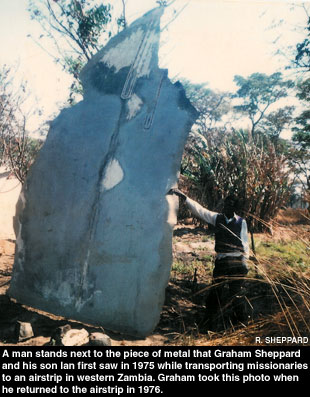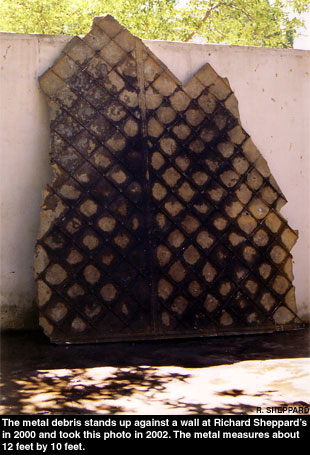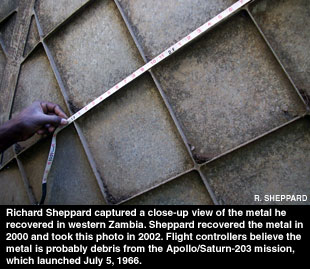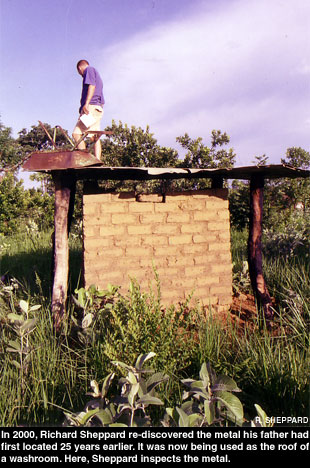|
|

|
Out of Africa
by Brad Thomas, JSC Space Center Roundup
What do a rocket, NASA engineers, an African safari guide and an outhouse have in common?
They are involved in a 30-year-old mystery that has come to a close.

February 28, 2006 -- Well... almost.
The mystery began in 1975 when Graham Sheppard was flying doctors to a remote landing strip in western Zambia. Sheppard, accompanied by his then 6-year-old son Ian, saw a piece of metal near an airstrip that caught his eye. According to the Sheppards, the out-of-place piece of metal had numbers, a NASA inscription and "U.S.A." printed on it.
Graham took a picture of the metal with a local man posing next to it when he returned to the site in 1976.
Years later, Graham showed the picture to his younger son, Richard. This sparked Richard's interest in recovering the metal and finding out its origins. Since Richard was an African safari guide in Zambia, he was able to search for the object.
Following his first failed attempt due to poor road conditions in 1999, Richard resumed his search to locate the metal in 2000. He first went to the West Two Airstrip in Zambia, where his father thought he had seen the metal 24 years earlier.
Just as he was concluding the search at West Two with no results, his fortunes took an abrupt upward turn when he showed the picture to a local woman. She knew the man in the photo and told Richard that the man lived by the West One Airstrip.
Richard went to the West One Airstrip and quickly had success. He discovered the debris in a most unlikely place. "We went down the road," Richard said, "and it was being used as the roof of a washroom."
Richard said the metal on the outhouse stood out in the area because the buildings were mostly constructed with mud bricks and thatch. He purchased the metal from the villagers for $200, which he said was nearly a year's salary for a villager, and took it back to his ranch.
Unfortunately, all of the identifying marks that appeared on the original piece of metal were gone. The villagers told Richard that many years ago, Europeans had cut off the four-foot by four-foot piece that contained the markings, leaving the remaining piece measuring about 12 feet by 10 feet.
Where did it come from?

Now that Richard had found the metal, the next step was to determine where it came from.
Richard eventually made contact via e-mail with several people at the Johnson Space Center Astronomical Society. One of those contacted was Chuck Shaw.
Shaw, who is currently serving as mission director for Hubble Space Telescope Servicing Mission 4, said the ensuing investigation involved both current and past flight controllers.
After months of investigating, the group began leaning toward Apollo 6 as the source of the metal debris. Apollo 6 was the final uncrewed test mission prior to NASA's successful missions to the moon. The mission's objectives were the final qualification of the Saturn V launch vehicle and Apollo spacecraft for the upcoming crewed lunar flights.
Apollo 6 became a possible source because the Saturn V rocket experienced engine problems on its second-stage burn. The spacecraft did reach its desired orbit, but flight controllers burned the engines longer than planned. The second stage reentered the atmosphere further downrange than planned, placing the potential debris footprint over Zambia.
Richard and Ian traveled to the United States in November 2005 and visited Rocket Park looking for an answer to the metal's origin by matching the debris to the Saturn V rocket.
A new twist

However, further investigations in December led to another and more likely source of the debris — the Apollo/Saturn-203 (AS-203) mission.
AS-203 was an uncrewed test flight of the Saturn rocket. It launched from Kennedy Space Center in Florida on July 5, 1966. "Apollo 6 was looking like a good bet until we discovered that this mission (AS-203) had debris in Zambia," Shaw said.
According to a list from the Senate Committee on Aeronautical Space Sciences report published in 1972, a piece of metal similar in size to that of the Sheppards' was found in Zambia in July 1966. It was identified as a piece of the Saturn-IVB stage of AS-203 rocket.
Later that year, another piece was found in Swaziland, also in southern Africa. It was identified as a part of the Saturn-IVB stage of AS-203. To date, Shaw said there is no evidence that Apollo 6 debris has ever hit land.
"We know that the vehicle fragmented early on the fourth orbit," Shaw said. "They were doing a pressurization check between the ground station at Corpus Christi and Trinidad."
Shaw said that it was very possible that debris from a rocket launched in 1966 could stay undetected for many years. Another factor pointing to AS-203 is that pieces of the Saturn-IVB stage have the same waffle pattern as the piece found by the Sheppards.
Even though there is a strong case for AS-203, it may not ever be confirmed as the source.
"We will never know for sure," Shaw said. "But it looks like AS-203 is the source of the debris. It is not unreasonable to think that more than one piece could land there."
Lessons learned

Shaw said the efforts to find the source of the metal have been a good experience. "It was gratifying that people around the world hold our accomplishments in such high regard," Shaw said. "I made a couple of new friends from the other side of the Earth."
In addition to being fun, he said that his research has inspired him to write the best documentation he can. "It was neat looking back in time. [The Apollo engineers] did a good job at documenting day-to-day activities. It makes me want to do the best job I can in documenting our activities."
Researching the notes from his predecessors has also given Shaw a better understanding of what went on during NASA's Apollo missions.
"You can read about the Apollo Program and about all they did," he said, "but when you read the notes, it brings it to life. It gives you a better appreciation of the challenges they faced."
As for the current location of the metal debris, Richard shipped it to the United Kingdom, where it is at a friend's house. Richard is exploring options on what to do with it next.
Unfortunately, Graham passed way in August 2005 before his sons could visit JSC and learn about the possibility of the out-of-place object originating from AS-203. The brothers said they continued the quest to discover the origin of metal with their father in mind.
"It was something he was very interested in," Richard said. "He was very fascinated with the space program. It was a tribute to him."
"It is like coming full circle," Ian said. |

© 2023 collectSPACE.com All rights reserved.
Questions? E-mail contact@collectspace.com

|
|

|

|
